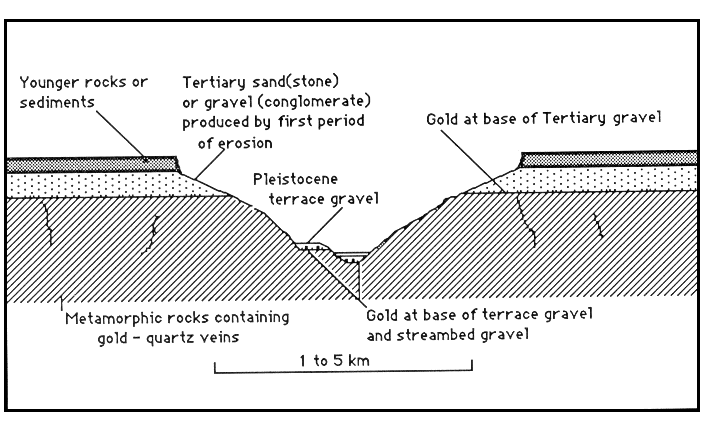
DESCRIPTIVE MODEL OF PLACER Au-PGE
MODEL 39a
By Warren E. Yeend
DESCRIPTION Elemental gold and platinum-group alloys in grains and (rarely) nuggets in gravel, sand, silt, and clay, and their consolidated equivalents, in alluvial, beach, eolian, and (rarely) glacial deposits (see fig. 195).
Figure 195. Cartoon cross section showing three stages of heavy mineral concentration typical of placer Au-PGE deposits.

GENERAL REFERENCES Boyle (1979), Wells (1973), Lindgren (1911).
GEOLOGICAL ENVIRONMENT
Rock Types Alluvial gravel and conglomerate with white quartz clasts. Sand and sandstone of secondary importance.
Textures Coarse clastic.
Age Range Cenozoic. Older deposits may have been formed but their preservation is unlikely.
Depositional Environment High-energy alluvial where gradients flatten and river velocities lessen, as at the inside of meanders, below rapids and falls, beneath boulders, and in vegetation mats. Winnowing action of surf caused Au concentrations in raised, present, and submerged beaches.
Tectonic Setting(s) Tertiary conglomerates along major fault zones, shield areas where erosion has proceeded for a long time producing multicycle sediments; high-level terrace gravels.
Associated Deposit Types Black sands (magnetite, ilmenite, chromite); yellow sands (zircon, monazite). Au placers commonly derive from various Au vein-type deposits as well as porphyry copper, Cu skarn, and polymetallic replacement deposits.
DEPOSIT DESCRIPTION
Mineralogy Au, platinum-iron alloys, osmium-iridium alloys; gold commonly with attached quartz, magnetite, or ilmenite.
Texture/Structure Flattened, rounded edges, flaky, flour gold extremely fine grained flakes; very rarely equidimensional nuggets.
Ore Controls Highest Au values at base of gravel deposits in various gold "traps" such as natural riffles in floor of river or stream, fractured bedrock, slate, schist, phyllite, dikes, bedding planes, all structures trending transverse to direction of water flow. Au concentrations also occur within gravel deposits above clay layers that constrain the downward migration of Au particles.
Geochemical Signature Anomalous high amounts of Ag, As, Hg, Sb, Cu, Fe, S, and heavy minerals magnetite, chromite, ilmenite, hematite, pyrite, zircon, garnet, rutile. Au nuggets have decreasing Ag content with distance from source.
EXAMPLES
Sierra Nevada, USCA (Lindgren, 1911; Yeend, 1974)
Victoria, AUVT (Knight, 1975)